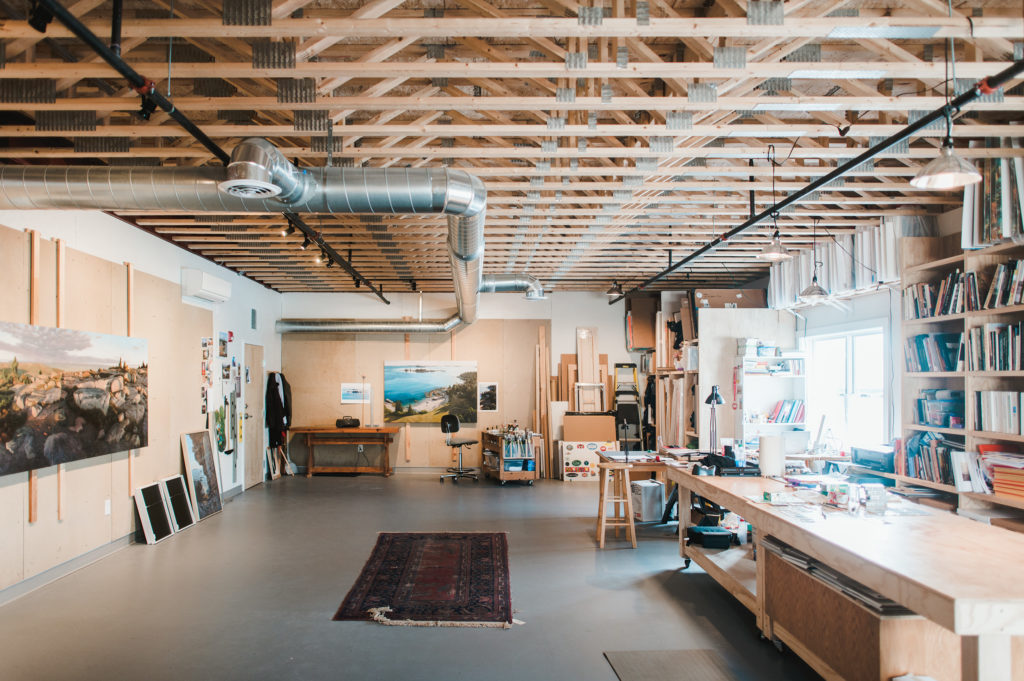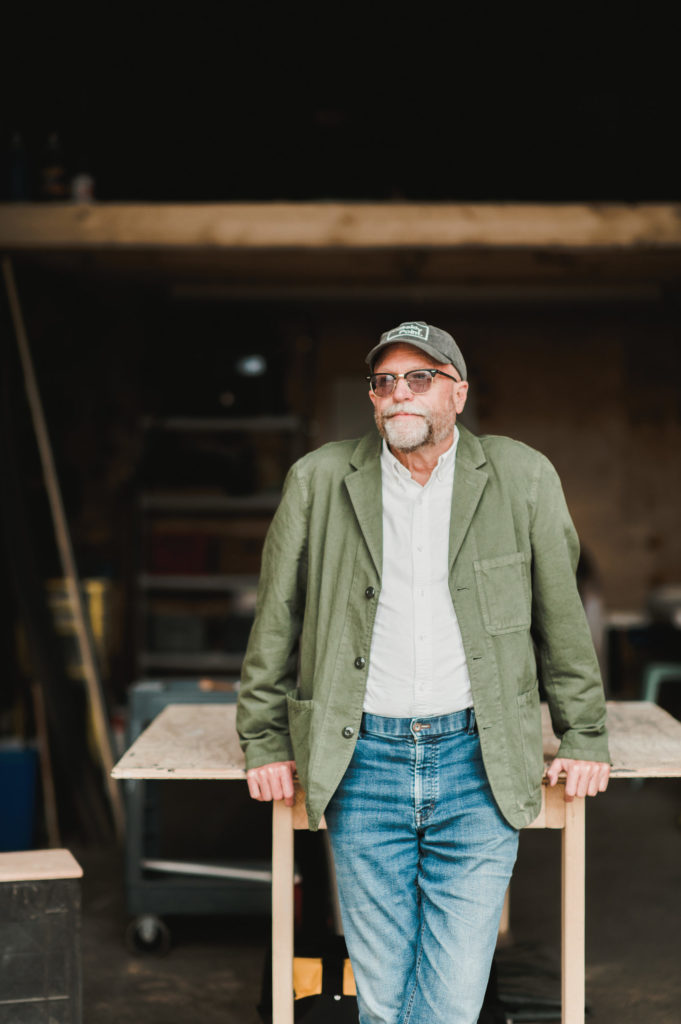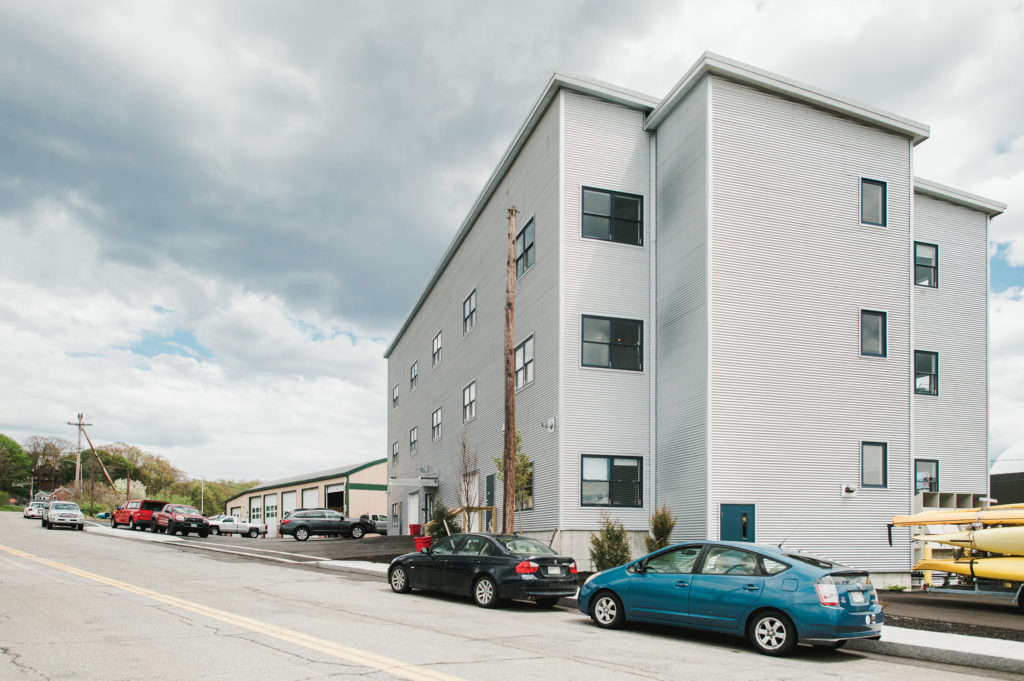Portland’s Newest Artist Studio Embraces Industry
Cassidy Point on Commercial Street provides much-needed studio space for Maine artists.

At the western end of Commercial Street in Portland, where the Fore River begins to widen into Casco Bay, large and small commercial boats of all kinds are in the water, freight trains and massive trucks lumber over the ground, and the sound of gulls competes with the noise of heavy equipment. The buildings are utilitarian and impressive in appearance, with metal cladding and simple forms. One building both harmonizes with this environment and stands out due to its elegance: Cassidy Point.
“Those trucks are bringing in loads of salt,” say Cyrus Hagge, the visionary developer behind the Cassidy Point artist studio, as well as a number of Portland projects that have helped revitalize the city. He’s surveying the activity from his sunlit office on the third story of the building. The Cassidy Point building, designed by Tracie Reed of Dextrous Creative, was completed in 2020 to provide generous, affordable studio space for artists—manufacturers in their own right, continually in the process of creative production. “If I can’t walk to it, I don’t want to own it,” says Hagge, who is president of the Portland Museum of Art’s board of trustees and serves on Space Gallery’s board of directors. “I’m Portland-centric. I wanted this to be a Portland project.” And Portland artists have responded to his project with intensity. “All of our leases were signed on the same day,” Hagge says. Artists from across the region are hungry for the light, air, and expectation of industrial-scale creative labor that the building offers. Unlike other studio buildings in the Portland area— repurposed structures to which artists must adapt— Cassidy Point is purpose-built with the creation of artwork as the only goal for use. Sculptor Aaron T. Stephan’s massive structures appear and disappear from the parking and loading area; artist Lauren Fensterstock pieces together hybrid objects for the Smithsonian American Art Museum and other venues; photographers Jocelyn Lee and Winky Lewis plan expansive compositions and tableaux; and artists from other creative disciplines similarly expand their practices.

Portland developer and arts supporter Cyrus Hagge in his Cassidy Point workshop. 
Artist Claudia Sperry in her studio space. 
Mullen at his studio worktable, where he creates his composite images of the Maine coast.

“This is the best space I’ve ever worked in,” says Jim Mullen, a landscape painter whose practice centers on depicting broad expanses of land and sea, sometimes with surprising horizon lines and disorienting vantage points. “I met with Cyrus last spring, in the midst of everything that’s crazy, and I signed on before it was even framed out.” The studio, with filtered northern sunlight, high bookshelves, and an uninterrupted 40-foot wall, offers a place for his work to expand and change. The wide, horizontal format of his work matches the generous breadth of the studio, which allows him to look at more of his work at once. “There’s a germination process, where I can put up source imagery, I can put up works in progress, and it becomes a visual conversation where I can start to bounce between things and see connections, and identify things and extrapolate from that,” Mullen says. “For the in-progress openness of letting things cross-pollinate, it’s really wonderful.” The studio radiates a generosity of scale at the same time that it holds a kind of peace and stillness; the space becomes a quiet, translucent container for the air that flows through Mullen’s intricate depictions of wide-open spaces.
This expansive scale combined with a sense of peace is something Hagge was intent on providing. Many artists requested large spaces, and creating a calm space started with Hagge’s decision to hire Reed as the architect. “I wanted a building designed by a woman,” he says. “Not that I’d necessarily come up with something different, but I felt that she would understand what would make people feel comfortable, because I knew that most of the tenants of this building would be women artists. I wanted them to be able to come into the building and feel safe after-hours.”

The building feels like an airy hermitage set away from the demands of everyday life, partly because of its location in Portland’s industrial outskirts: “We’re on the end of the known universe,” Hagge says. There are no other signs of cultural activity in sight, but here, artists’ productivity is acknowledged as a fundamental form of labor by the studios’ design and function. As the first building built in Maine specifically for artists’ studios, a sense of flexibility, industry, and trust in the productivity of artists is reflected in every room and hallway. Even the plumbing, which includes a slop sink with a hose attachment in a niche near a bathroom, is designed with the expectation of artists engaging in ambitious creative practices.
At Cassidy Point, the work of creative professionals exists alongside oil tankers and heavy industry. Its site is intrinsic to its purpose. “That’s the visionary aspect of it,” Mullen says. “It manifests a clear prioritization, that creative work matters and contributes to the community’s sense of well-being.” In a section of Portland that is most noteworthy for its unceasing industrial action, the artists at Cassidy Point have found a place where creative practice is recognized as crucial to the Maine economy, culture, and way of life. Artwork is recognized here as labor that drives daily life, like the work undertaken by the oil tankers and freight trains outside their studio windows. In this environment, they can get to work.





